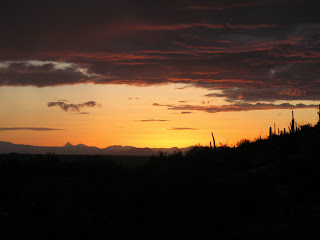Do you remember, back in the early 90's, the story of the Biosphere 2 in Arizona? I was fascinated at the time by the notion of eight people, sealed inside a glass dome, determined to live self-sufficiently for two years. They grew all their own food in a 3-plus acre microcosm of our own earth, the original biosphere or what they termed Biosphere 1. Major climates of the earth; rain forest, savannah, and desert, plus an ocean complete with a coral reef, were re-created under glass. The eight Biosperians all survived, although emergency oxygen did have to be pumped in at one point. (Microbes consumed oxygen at a greated rate than the scientists had predicted.) So what became of Biosphere 2 and the Biospherians?
Here it is today.

For $19.95 per person, with a 10% discount for AAA members, you get a one-hour guided tour. Our tour guide has been giving tours since September 1991, when the experiment began. We learned that Biosphere is, was, and always has been privately owned and funded. The project was conceived as a way of experimenting with systems for sustaining life that could have applications in extended time space travel and exploration.
Imagine passing through these air-lock doors, knowing that you and seven other people are solely responsible for your collective survival.

The living and working areas of the Biospherians lie just inside this entrance. Each person had their own apartment totalling less than 500 square feet, consisting of a living area on the main level and a spiral staircase leading to sleeping quarters. Here is one version done as an artist's studio.

Each of the eight Biospherians took turns cooking all the meals for the crew for one week at a time. Here is their communal kitchen.

Remember, nothing is coming in or out of this 3-acre dome for three years. Would you really want to use oven cleaner, bleach, or even hairspray, if you lived inside here? And this dome is just a microcosm of our planet earth. This started me thinking and wondering why we want to pollute Biosphere 1, our own earth, with such toxic chemicals.
The Biospherians grew all their own food and each one ended up losing a fair amount of weight. They did get their coffee though - one cup for each person every two weeks!
A variety of climate zones was replcated under the glass, separated from the climate-contolled living quarters and office space. First up, the rain forest. Note the humidity which shows up as fog in the photograph. You really didn't see it while in it.

A short boardwalk brought us to the savannah, with a view of the Catalina Mountains beyond the dome.

Beyond the savannah lies the desert. This desert was replicated not to be like the Tucson area desert, which is the Sonoran Desert, noted for the saguaro cacti. No saguaros were brought into the Biosphere. Rather, the intended environment was that of the Baja Peninsula in Mexico. This desert is a "fog" desert because it gets moisture from the sea on both sides.

It was no small engineering feat to keep the temperature and humidity tightly controlled in every zone. Here is a small part of the basement, with the pumps and storage tanks for handling water in the desert basement.

Also located underground are the "lungs" of Biosphere. Think about it - as temperature fluctuated so would air pressure, and the amount of space required for the air would expand and contract. The black ceiling material would rise and lower accordingly. (The support brackets that you can see in this picture were added after the experiment of the closed environment ended.)

Access to views of the man-made ocean tank also lies underground. Posted on a sign next to the tank is this explanation:
"The Coral Reef Biome contains 750,000 gallons of water. 100,000 gallons were brought by truck from the Pacific Ocean off San Diego. The other 650,000 gallons of seawter were prepared by mixing 'Instant Ocean' (a commercial sea salt) and Biosphere 2 well water."Fish still swim in these waters. Here is a small section of living coral reef.

Ed & I had a chance to chat with our guide after the tour. Ed wanted to know if there were any species that tried to "take over." It turns out that Morning Glory vines were a real problem. Morning Glory is outlawed in Arizona and we all wondered what the botanists were thinking who allowed it in Biosphere 2. I asked what beacme of the original 8 scientists who conceived, designed and inhabited the Biosphere fifteen years ago. Most of them have never come back and some, in fact, were not welcome to come back anyway. Apparently, there was a lot of interpersonal tension and disagreement. I am looking forward to reading Jane Poynter's book, "The Human Experiment: Two Years and Twenty Minutes Inside Biosphere 2". It's on backorder from the publisher but I am looking forward to getting the scoop from Jane as a true insider!























